This is the second part in my serial guide helping you to identify where you’re at now so that you can set your diet and training up accordingly to make the fastest possible progress. (Part 1 here)
This part we cover two categories of trainees, Skinny, and Shredded. – Very different physiques, but very much related in terms of diet strategy. Two lessons here:
- Why You Are Still Skinny, What You Need to Change, and What Pitfalls You Need to Avoid.
- How to Slow-Bulk – Avoiding the Dream-Bulk Trap
I share a lot of my own personal lessons in this part of the guide having languished in that skinny category for a long, long time and also having gone on a couple of dream-bulks myself.
Category 4. Skinny – very little muscle, low body fat.

Image credit – Leigh Peele
Strategy: Bulk
‘Skinny’ is the category that I was in for most of my mid-late teens, and early twenties. It isn’t a flattering term and it’s not what anyone wants to hear as a description of themselves. However, it is an exciting category to be in as you will see the biggest changes of your life over the course of the next 12 months if you get your training and diet right. As you’re reading this site there is no reason why you shouldn’t be able to do that. I went down a longer, harder road.
How Quickly Can You Grow?
You’re a beginner. You are set to gain 2-3lb of muscle per month for around 3-6 months, and then 1-2lbs of muscle for the following six-nine months. That’s 15-25lbs of muscle over the course of your first year. If these rates in any way seem slow to you, next time you’re in the supermarket have a look at how much steak that is and imagine it strapped to your body in a year’s time. Motivated? Good.
Muscle Growth Potential Training Status | Gains/month | Energy Surplus/day Beginner | 2-3lbs | ~200-300kCal Intermediate | 1-2lbs | ~100-200kCal |
Exceptional circumstances aside, aiming to gain 100% muscle and zero fat is simply not a realistic expectation. Part of your bodyweight gain will be fat, however you may not notice it (or it may not bother you) cause you’ll look bigger and leaner despite carrying more fat overall. In the image above look at the guy on the left and picture him with a little more body fat. If you currently look like the guy on the right, you’ll be happy with the change, yes? That is very doable over the course of the next year. You’ll then be able to cut to your first set of real defined abs, and you’ll build from there.
“Part of your growth will be fat gain, however you may not notice it.”
Firstly though, you need to identify why you are skinny in the first place, or you are doomed to repeat the same mistakes again.
Why You Are Skinny
You’re underweight for a reason, whether due to a conscious decision or not. Here are the two most likely culprits for why that is the case:
Skinny Due to a Conscious Decision
You might think it quite strange for me to say that someone might diet their way to being skinny, but consider the following:
- Everyone that hasn’t dieted to near competition-level lean before believes themselves to be more muscled than they actually are. Everyone.
- Most people without any training experience believe they will put on muscle quicker than they can if they start training.
- ‘Quicker’ is nearly always considered better, when you don’t know any better. So inappropriately high calorie deficits are common.
What you get then is a lot of skinny-fat people dieting too quickly, without an appropriate resistance training program, and losing the little muscle they had to start with. They are then left wondering where their abs are hiding. [A lot of ‘fat and weak’ category people get themselves into this ‘skinny-fat’ category this way.]
Eating more will not be hard for this category of people, unlike the naturally skinny guys.
Naturally Skinny
If you are in this category without any conscious effort on your part then it is likely because you don’t have a big appetite. This is not to say that you can’t eat huge portions at the buffet (you may even be known for it), but you will subconsciously reduce your food intake for the rest of the day (or the following one) to make up for it when you do. This is in contrast to most people that will eat themselves into a mess when faced with multiple buffets each day. (I find it interesting that while technically buffets should be the greatest friend of the dieter – because it allows us to choose exactly what we need rather than rely on arbitrary restaurant portions – it rarely works out that way)
You are also probably a high NEAT responder, meaning that you subconsciously get more active (fidgeting or otherwise) when you do overeat.
This is genetically how you are set up. You will find maintaining a lean physique relatively easier than others when you get there, but you will need to consciously try to eat more. It is not sufficient to guess whether you are eating more based on fullness, portion or macro/calorie counting is a necessity. You will likely need to choose more calorie dense and palatable foods than you usually would in order to eat enough without feeling uncomfortable. You should also consider a higher meal frequency if you have trouble.
Recommendations
- Set a weight-gain target of around 50% above what you see in that table, this way you won’t compromise your muscle growth potential. (e.g. If you’re a tall guy, shoot for ~4.5lbs per month of weight gain, shorter guys go for 3lbs/month)
- Ignore the first week’s rise in scale weight as that will just be a change in water balance due to the higher carb intake.
- Bear in mind that due to a high NEAT response you may need to eat a lot more than you calculate you need. Tracking trumps calculations.
- Focus on strength acquisition. This will keep you from second guessing whether you are making progress when the mirror starts messing with your head.
Force your body to get stronger, eat enough to support that.
Common Pitfalls for “Skinny” Category Trainees
1. Choosing a gym that lacks the equipment you need because it is cheaper or more convenient. – Don’t unless you have to. Ok so you have read that the leg press with appropriate supplemental exercises can get the job done, but that’s if you know what you’re doing (which you don’t yet). A gym without a squat rack is a bad idea for reasons that you probably haven’t considered yet: poor atmosphere and uptight staff that will not let you do what needs to be done. It is worth paying a little more and traveling a little further to be in an environment that is conducive to your goals. Seek to be surrounded by people that are stronger than you, as they will make you believe in yourself, and that will have huge long-term impacts on your physique. (note: Do not confuse a smith machine with a squat rack. If you cannot separate the bar from the rack, it is not a squat rack)
Related: Why do you prefer BARBELLS OVER BODYWEIGHT workouts? →
2. Not focusing on strength acquisition.
3. Not following through with your strength training program. – Do not get distracted by a routine you read in a magazine advertising drop-sets, supersets, giant-sets and all sorts of other cute sounding stuff. These things aren’t remotely relevant to you until you have built a solid base of strength. Do not add things in. Just follow the program.
4. Struggling to get the training handled. – You must train with correct form and bring enough intensity to your workouts. 99% of staff in commercial gyms don’t have a clue how to coach the barbell lifts, so if you are stuck training in one of those you probably need to teach yourself using books, and instructional videos online. Most people do it this way, I did this, you can too. Just beware of other gym members (especially in the commercial gyms) that will come over to you ‘to help show you correct form’. They mean well, they might be right, but it’s equally likely that they don’t know what they are doing. A common one here is for a beginner to be trying the low-bar back squat, and have someone that only knows about high-bar back squats, walk over and tell them they are doing things wrong. It doesn’t matter which you do, but you need to choose one style and stick to it. Either way, if you make yourself familiar enough with the material then you will be able to judge when something isn’t right.
Client Examples
There are a few guys in particular that come to mind that I’ve worked with, but I won’t be asking them if they would like to share their pictures here, just incase it’s taken the wrong way and instead of it coming across as high praise I unintentionally hurt some feelings.
If you are a former client reading this, proud of your progress, and are up for sharing here so that you can inspire others, please send me an e-mail.
I have no qualms about embarrassing myself though…
Personal Story
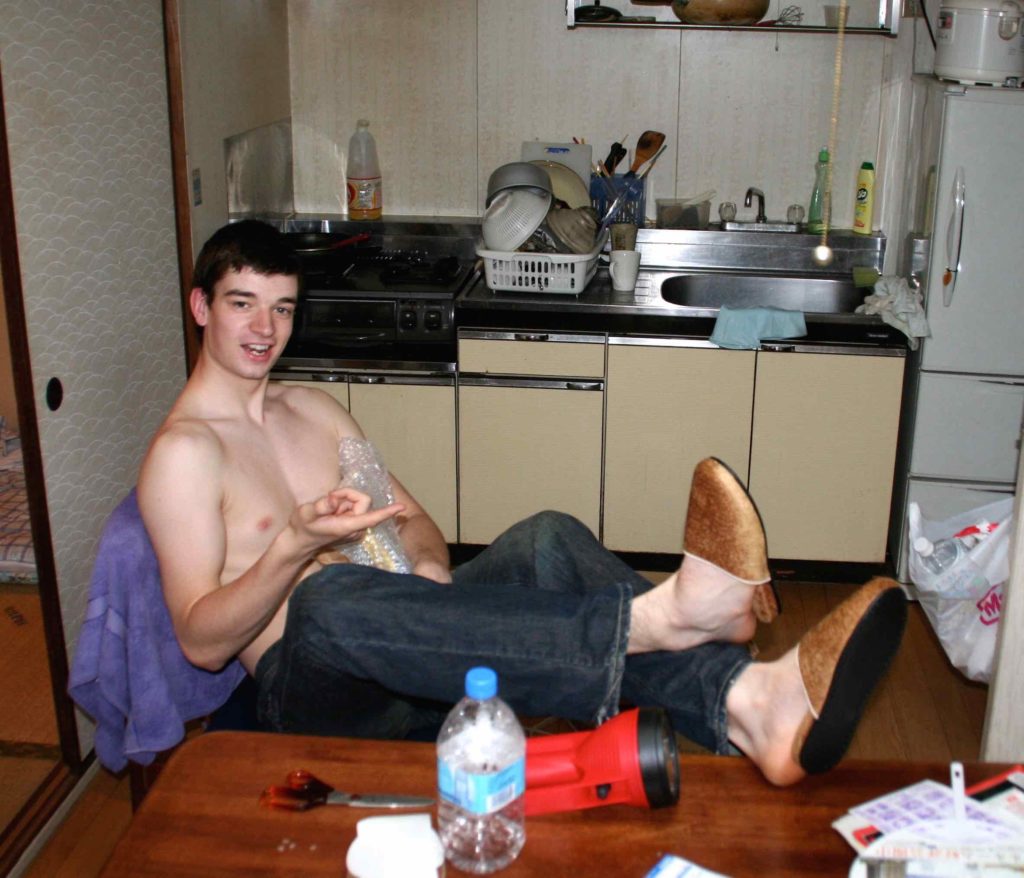
Shortly after moving to Japan, 22. (The only shirtless pic I could find around this time)
Now just to be clear, I don’t feel embarrassed about this picture because I was thin – but it is a little embarrassing to say that this was 4-5 years since I started going to the gym, with the specific intention of getting bigger, to not look like such an easy target for another glass-bottle-wrapped-around-my-head situation. I looked less lanky than I used to, but that is definitely not the kind of progress that I should have made.
(As you can see, I’m far from the typical fitness industry guy – physically gifted to begin with, played a lot of sports in school, went to the gym as a hobby and just gravitated into training people. Personally, I think that’s why there are so many bad trainers out there – they simply can’t understand how tough some people have it)
I was doomed to keep messing up for the next 3 years until that girl’s comment on the beach in Goa (summary: Do You Even Lift?) woke me up to reality.
Though the progress I made with my gym efforts in my first ~7 years is kind of laughable when I look back on it, the struggles of the past are what makes us who we are. I have no regrets. I just don’t want you to repeat my mistakes, which I feel were:
- Naturally skinny but I didn’t eat enough. I was scared of fat gain and wanted my non-existent abs to come out.
- Complete neglect of the compound barbell movements, no attention to the lower body or posterior chain. I think I got completely lost in lifting more and more with my dumbbell presses. Despite getting up to 90lbs/side with a hefty spot and shitty form at one point I managed to cheat myself out of a good training effect in nearly everything but failed to realize it. (With barbells you’re less likely to do this – you can lift it or you can’t. So when you haven’t gained any strength for a while, you know you’re not getting bigger – generally speaking anyway)
- Ignoring calorie requirements and macro setting.
- Crappy gym environments. – Looking back, this was the number one reason for my lack of progress. Everything else fell into place when I finally started going to a good one.
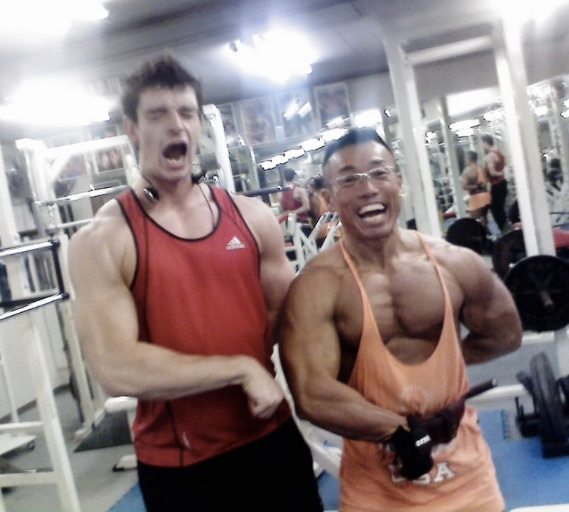
Taken ~12-18 months after the Goa beach comment. Looking through my old photo albums for a shirtless “before” picture to accompany this was like hunting rainbow-colored unicorns – I wouldn’t take my shirt off. I’m not in the habit of taking pictures at the gym and have my old buddy Jeremy Mangos to thank for capturing this moment of mock-vanity with the beastly Takeshi Okumura. I hadn’t yet realized the value of tracking things so I don’t have data.
***********
[Update: Thanks for Chandler for mailing me offering to share his progress. I’d put him somewhere between the two categories featured in this post in the left photo. He had been spinning his wheels for a while before this also.]
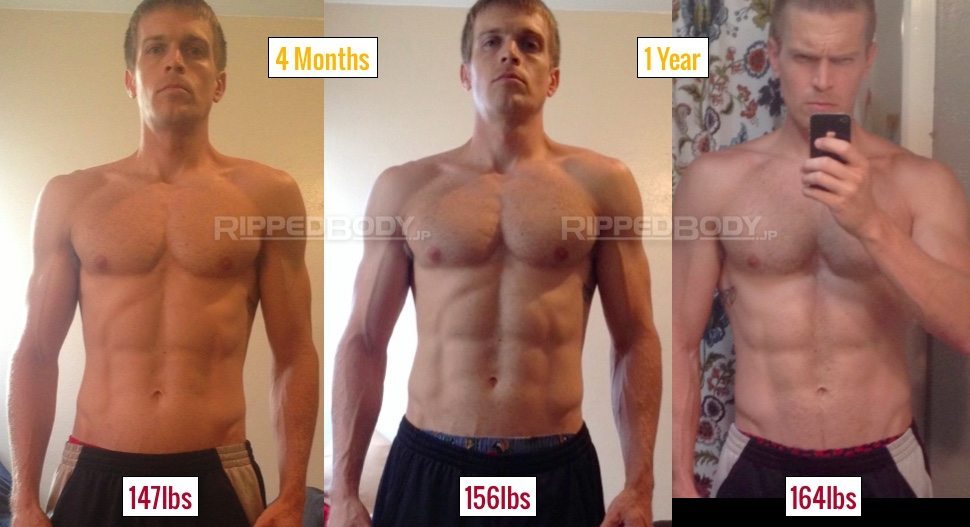
| If you are in this category, I want you to get motivated by what I’ve written above, but it is not intended as an advert for my coaching services. For me to be able to get people the results that they want, I need to know they are comfortable/proficient with the main compound lifts. As a minimum, I ask that people give themselves two honest and sincere months of work with barbells first before applying, as that way I can get a good idea of whether they know what they’re doing or not based on how they progress in that time. Some people just seem incapable of learning on their own and are better off hiring someone locally. I want you to be successful. I just don’t want anyone to have paid me and be unsuccessful due to something I have no control over. |
Category 5. Shredded (Clear, defined abs.)
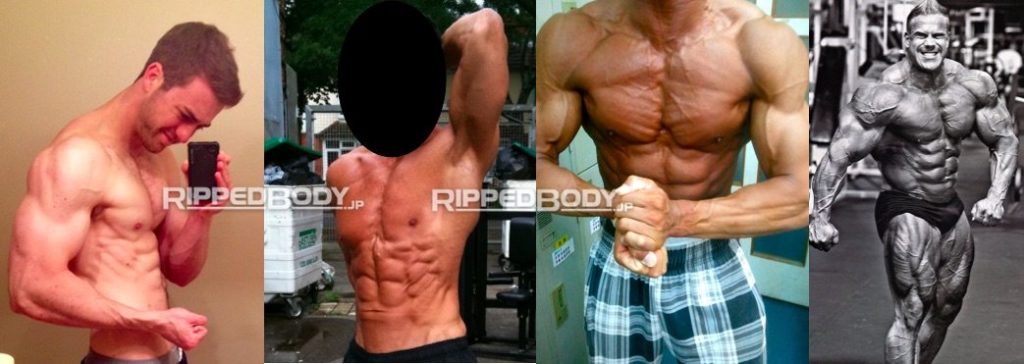
Joe, Phil, Sadaaki, and Jay all have differing levels of body mass, but I would consider them all to be shredded. (l-r)
Strategy: Maintenance or Slow-bulk
If you are happy to simply be at a period of maintaining your physique, then see my guide to finding the maximum you can eat while maintaining your physique after dieting. If you are looking to improve and haven’t reached your likely genetic ceiling then this guide is for you.
‘Shredded,’ ‘ripped,’ I’d like to make these subjective wordings more defined here to help with explanations moving forward.
‘Shredded‘ means to have a very low level of body fat (7-8%), with a decent enough amount of muscle.
‘Stage-shredded‘ – means to have a low enough body fat to be competitive on stage (this will generally be anywhere from 5-8% depending on the level of competition, for naturals of course).
‘Ripped‘ is the same general idea as shredded, but with a touch more body fat (9-11%).
‘Decent enough amount of muscle‘ means that you wouldn’t be described as skinny if seen at the beach by the majority i.e. >90% of people. This is highly subjective, but what is considered to be a decent amount of muscle will inversely correlate with body fat in most people’s eyes. Meaning, the leaner you are, the more muscle you need to look good. When you are lean, there is no pretending that the fatty padding over your muscles is actually muscle. A shredded guy with more body fat will look ripped, but a ripped guy won’t necessarily look shredded if he loses more body fat – he might cross the threshold into skinny.
The advice here covers all of these labels, as well as our 10% guy from the previous section. He wouldn’t really fit in any of the categories above. (Cutting from here isn’t going to get him any nearer to ripped or shredded as he would just look skinny. He needs to start a bulk phase)
How Quickly Can You Grow?
This depends on your training status, height, and how close you are to your maximum natural genetic limit. By this stage though we’re talking about 2lbs or less per month. In the pictures above, Joe has the biggest scope for growth per month, Phil the second most, Sadaaki is close to his genetic potential, Jay exceeded it a long time ago.
You need to set your calorie surplus at a level that gives you an appropriate rate of weight gain per month for your level of training experience and development. If you eat too little you will hamper your hard work in the gym by not providing enough calories for growth. If you eat too much your body will store the excess energy as fat. Extreme cases of the latter are called a dream bulk, which we’ll come to later.
If you’re a lifter that has been focused on gaining strength in the barbell movements or has put those movements at the core of your workouts, then you can determine your training status fairly objectively using Martin Berkhan’s guidelines here, section Progress and Goals. If not, check out Lyle McDonald’s guidelines on training experience and maximum muscular potential here.
Muscle Growth Potential Training Status | Gains/month | Energy Surplus/day Intermediate | 1-2lbs | ~100-200kCal Advanced | 0.5lbs | slight surplus |
Recommendations
- For maximal hypertrophy with manageable levels of fat gain, set weight gain at 50-100% above what you see in that table.
- For maximal maintenance of leanness, increase your calorie intake only when you cannot progress in your workouts rather than setting a weight-gain target. (If you choose this method just be aware of my comments in the ‘Common pitfalls’ section below)
- Keep your body fat percentage under 15%. If you hit this, cut back down to abs (10% will do) and then start another slow-bulk cycle. This is for both health and optimal calorie-partitioning reasons. (Basically, the fatter you get, the less able you are to build muscle relative to fat when gaining weight)
- Train hard – you’re likely in the intermediate stage now and will need to consider increasing volume to progress. First though, see how your body responds to the increased calorie intake with your current training plan – you may find that it is not necessary to change things up yet.
You will probably find the “Slow Bulking: Muscle Growth Expectations and Setting Calorie Intake” section of this guide of mine useful. I have adjustment guidelines in there also to help you keep progressing. For optimal progress you will need to get your macros right too – so see my guidelines for that in the Nutritional Pyramid of Importance series.
Common Pitfalls for “Shredded” Category Trainees
1. Becoming obsessed with your level of definition, refusing to allow any fat gain in your quest to gain muscle, failing to make (or more importantly, see or measure) progress. It is for that reason that I would recommend chasing a sensible weight gain target rather than trying to maintain maximal leanness for most people.
2. Going on a dream bulk and simply getting fat, as I did in the winter of 2010-2011. This happens when people aren’t aware of their maximal growth potential, or they just ignore it because they don’t like the numbers they read. Aside from the cut taking longer afterward, you risk your health doing this, and if you do it too often, your skin elasticity too.
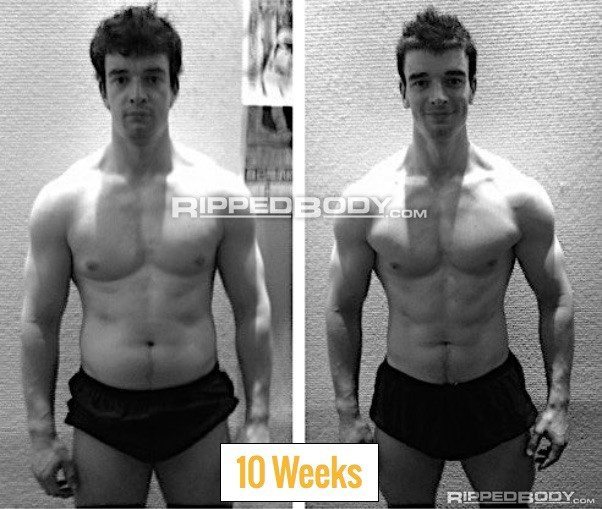 The photo on the left was the result of my second 25-30lb dream bulk (which I was certain would be at least half muscle this second time around). The 10 week cut you see above revealed my gains to be more like ~5-6lbs, which I then stupidly lost half of by continuing to cut too quickly, trying to go from ‘almost ripped’ to shredded. Two valuable lessons that I was glad to learn on myself before I started working with clients.
The photo on the left was the result of my second 25-30lb dream bulk (which I was certain would be at least half muscle this second time around). The 10 week cut you see above revealed my gains to be more like ~5-6lbs, which I then stupidly lost half of by continuing to cut too quickly, trying to go from ‘almost ripped’ to shredded. Two valuable lessons that I was glad to learn on myself before I started working with clients.
Though the dream bulk is alive and well among the bodybuilding community in Japan, Sadaaki (pictured next to Jay Cutler) and Takeshi (the guy pictured with me above, and on the stage below) are ahead of the curve – they are both at or close to their genetic muscular limits, and they’ve realized that there is no point in gaining a ton of weight in the offseason trying to force muscle gain that can’t happen. Their off-season and competition weights (water and glycogen changes aside) differ minimally. Everyone else seems to go on a 30-40lb dream-bulk regardless, which makes the gym New Year party pictures quite hilarious. (And yes, Sadaaki knows his triceps might be considered to be lagging, but trust me – it. is. not. for. lack. of. trying)
Takeshi Okumura – Stage shredded @~68kg (~150lbs), likely his genetic limit given how long he’s been competing. His height is 163cm tall (5’4). He’s won the all-Japan masters for his weight category multiple times and his best placing in international competition was fourth. (And yeah, I think this is his favorite pose)
Believe In Yourself
Switching gyms (when I actually started paying attention to what was going on around me) was the catalyst to finally start progressing. I started training with more intensity, and better form. I saw that nutrition was key to fueling that change and started thinking about calories and macros. But I think the biggest factor was simply that being surrounded by these guys finally made me believe in myself.
This makes me wonder – is that what makes a lot of the readers of this site successful also – they now believe they can so they are? How much does coaching add to this?
The power of empowering people to believe in themselves… fascinating.
*************
Thank you for reading. Questions are welcomed in the comments.
- What to do if you’re Overweight but New to Training.
- How to Avoid the Skinny-fat Trap and What to Do if you’re Stuck in it.

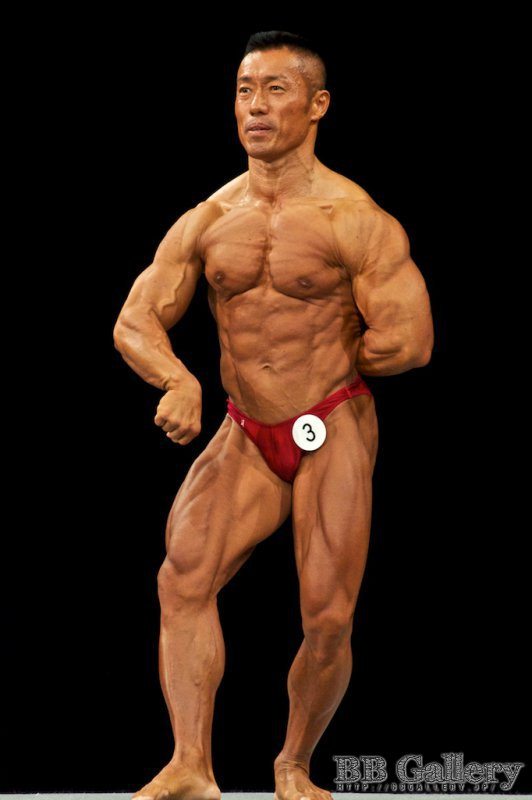

Privacy policy.